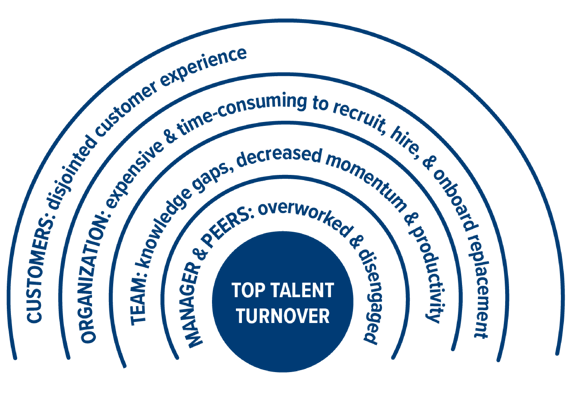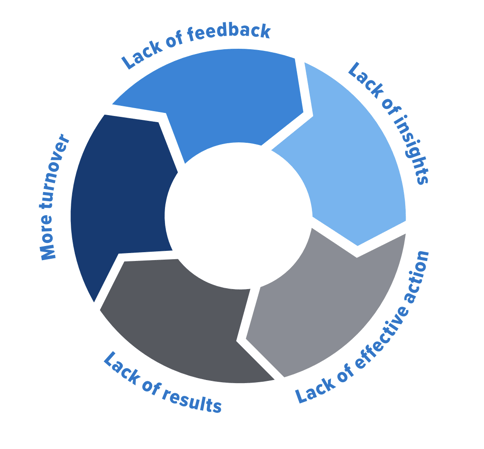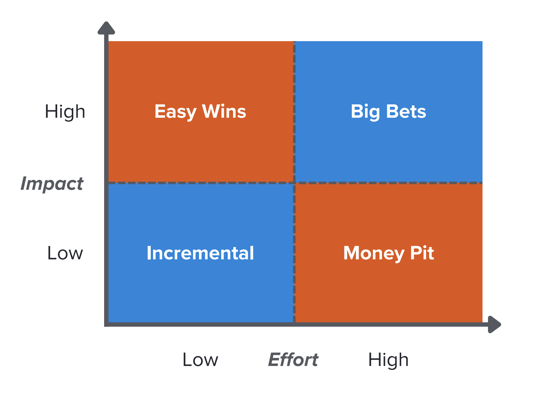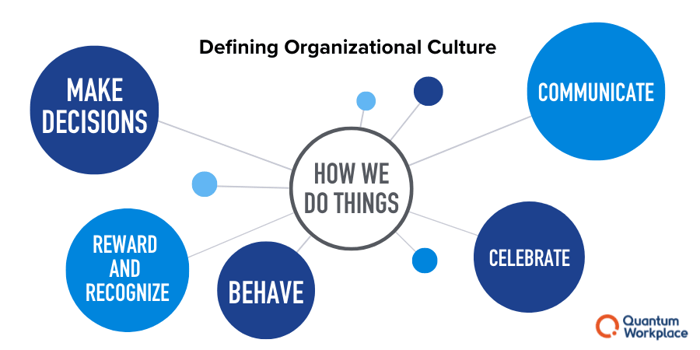How to Retain Your Best Talent: Approaching Retention with Intention
Your very best [insert critical role here] just RESIGNED 😲 They were the glue that held their department together. You had no idea this was coming. Now, your HR team is scrambling to cover gaps, client trust is wavering, and the team's morale has tanked.
Sound familiar? Unwanted turnover is EXHAUSTING—and waiting to act until someone quits? It's a losing strategy. But there's good news! Your key talent is sending you signals long before they leave. Are you listening? Are you ready to act?

We recently spent valuable time with two of our industry experts and a group of 100+ HR leaders discussing how to retain your best talent. The conversation was packed with practical advice, data-driven strategies, and real-world challenges that HR leaders and managers face daily.
📺 Want to watch the full recording? Click here! >>
One major theme emerged: employee retention isn't about reacting—it's about predicting, preventing, and equipping leaders to take action before turnover becomes a crisis. The takeaways from this conversation were too valuable to keep to ourselves. Keep reading if:
✅ You want to predict turnover risk before it's too late
✅ You have critical talent you need to retain
✅ You want to use employee feedback more strategically
✅ You know your organization is not moving quickly enough on retention
✅ You're struggling to turn data into actionable strategies
Meet the Experts!

Todd Pernicek, PHR, SHRM-CP
Senior Insights Analyst
Quantum Workplace
Todd helps organizations across industries translate employee data to action: tackling turnover challenges, improving retention, and fostering business growth. He helps identify key opportunities and bring meaning to the numbers, empowering HR leaders to drive results. His take on retention? It's a lot like flossing—companies only prioritize it when there’s pain. Winning organizations make retention a daily, proactive practice.

Meghan Freeman
Product Manager
Quantum Workplace
With a deep passion for making work better, Meghan brings a thoughtful, human-centered approach to product management at Quantum Workplace. She’s partnered with 60+ HR practitioners to tackle one of today’s toughest workplace challenges: employee retention. Her mission? Empower HR leaders to move faster, align with stakeholders more easily, and proactively retain their top talent with the right tools and insights.
The state of employee retention & turnover
57% of CEOs cite retaining and engaging existing employees as a top 3 priority for 2025. And while the average voluntary turnover rate continues to trend downward, research shows that job-seeking behavior is on the rise.
About half of U.S. employees are either actively searching for or watching for new job opportunities.
While employee retention is top of mind, leaders admit their retention strategies are not that effective. Most say their approach to retention is at the intermediate or beginner level. This simply won’t cut it as employee engagement and employee intent to stay have been on the decline.
No matter the state of the job market, keeping your best talent is critical to the success of your business. And employee engagement serves as a buffer in good times and in bad. If you’re not taking time to strategically address retention and turnover, you’re leaving a lot on the line. But we have good news! A lot of unwanted turnover is actually preventable.
1 in 3 employees that leave their organization say their departure was preventable.
There is hope in these numbers! A lot of time, money, engagement, and energy to be saved. But to make meaningful progress, you must shift your mindset and approach retention with intention.
Stop reacting ➡️ Start predicting & preventing turnover
Employee retention shouldn't be reactive. If it feels like you're scrambling to replace employees after they're gone, you're not alone. But the signs of disengagement and possible departures appear long before resignation letters hit your desk.
62% of departing employees said they discussed their decision with either their managers or coworkers before leaving.
Unwanted turnover can feel overwhelming. It's all too easy for leaders to go into fight or flight mode. To be paralyzed from uncertainty about where to even begin. But we must overcome. We can't:
- Make decisions on a hunch
- Enact broad, uninformed strategies
- Assume we know why employees leave
- Look at surface-level metrics
When we start taking action on turnover without data, measurement, and strategy, it creates a vicious cycle that isn't good for anyone.

🔉 Meghan's Take: "Engagement and retention strategies need to be data-backed and scalable. If you're only measuring engagement once a year, you're missing critical moments when employees are deciding to stay or go."
With the right tools, you can break this cycle. Not only can you shed light on what is causing top talent to leave. You can actually predict when such a catastrophe might be looming and deploy strategies to prevent it.
A key point in our discussion was that turnover isn’t usually something that happens overnight. Employees often show early signs of disengagement. Employees typically fall into two categories when it comes to signaling their disengagement:
The Silent Stewers
These employees quietly disengage and leave without giving much indication. Organizations that experience high voluntary turnover in certain roles or departments often assume that churn is inevitable. But this passive acceptance signals a deeper issue: a lack of awareness of why employees are leaving and what could have been done to retain them.
The Active Signalers
Most employees give feedback somewhere, whether in engagement surveys, exit interviews, or everyday conversations. The problem is organizations don’t connect the dots between macro-level trends and micro-level team dynamics. Key behavioral indicators, when analyzed effectively, can reveal pockets of turnover risk before employees make the decision to leave.
Leaders who actively monitor engagement trends, performance shifts, and employee feedback are far better positioned to act early. Creating an environment where employees feel heard before they start looking elsewhere is the difference between preventing turnover and reacting to it.
🔉 Todd's Take: "If we're waiting for an employee to resign before we act, we're already too late. The organizations that are winning are the ones who see the signals, trust the data, and take action before it's a crisis."
Making the shift from reactive to proactive
- Monitor early warning signs like declining engagement and feedback trends
- Use predictive analytics to identify employees at risk before they leave
- Build a data-driven retention strategy that allows for early intervention
Zero in on your most critical talent.
Not all employees have the same impact—retention efforts should be focused on the people who drive your business forward. Losing a highly skilled employee in a critical role can cause significant disruptions, while some roles may be easier to backfill.
🔉 Todd’s Take: "Some employees leave, and it doesn’t impact the business much. Others leave, and you feel the pain immediately—lost knowledge, disrupted workflows, lower morale."
🔉 Meghan’s Take: "Retention isn’t just an HR priority—it’s a business priority. If you’re losing top talent, you’re losing business impact, innovation, and future leaders."
Many organizations make the mistake of applying a one-size-fits-all retention strategy, but the most effective approach is to focus on high-impact employees—those in critical positions, high performers, and emerging leaders. Using performance data and engagement trends can help identify who is at risk, allowing organizations to act before top talent walks away.
Who should you prioritize?
- Employees in high-impact roles that are costly to replace
- Individuals with critical institutional knowledge
- Top performers who contribute to long-term business success
Make sure top talent sees a clear path
While career growth and recognition are top reasons for turnover, there's much to be done by the organizations that employees are leaving:
- 70% of employees said they didn't have a discussion about their future or growth in the 3 months prior to their departure
- 53% of employees say they weren't recognized for their contributions to the organization
Fuel your retention strategy with employee feedback & action.
Listening to employees is the foundation of retention success. Employees want to have a voice in their experience at work. They know better than anyone what might be causing people to leave—and many will share their ideas and concerns directly if you ask. To capture this kind of feedback, you must open up a variety of channels to help leaders listen.
Some leaders we’ve worked with are hesitant to ask for too much feedback, worrying about survey fatigue. Others don’t believe employees will share honestly. But our research shows employees are most engaged when:
- Leaders regularly ask for feedback
- Leaders regularly act on feedback
But if employees feel their input doesn’t drive action, disengagement follows. Employees quickly notice when their input doesn’t lead to change, and over time, they disengage from feedback processes altogether. The key isn’t just collecting feedback—it’s responding quickly, visibly, and effectively to demonstrate that employees’ voices matter.
Quantum Workplace research shows 35% of employees say their organization doesn’t effectively respond to survey results. But employees who witness action on their feedback are 12X more likely to be engaged.
🔉 Todd’s Take: "Data alone doesn’t solve problems. Acting on feedback does. Employees will only keep sharing their perspectives if they see that it actually leads to change."
🔉 Meghan’s Take: "When employees feel like their feedback disappears into a black hole, they disengage. The organizations that retain their talent act on what they hear, and they do it quickly."
How to turn feedback into action
- Use annual engagement surveys to establish benchmarks
- Leverage real-time pulse surveys to detect issues as they emerge
- Make sure employees see their feedback translated into meaningful changes
Move quickly & delegate effectively.
To move the needle on regrettable turnover, leaders must invest in swift action. You have to be willing to walk away from things that are no longer serving you and double down on what's needed to drive positive change.
Action should be focused on continuous improvement over time. Be agile and iterate as you receive new information and/or try things that don't work. Even the smallest shifts can make a big difference.
Once you've uncovered insights in your engagement, performance management, and turnover data, you need to prioritize. One of our favorite tools to use is an impact/effort scale. Ask yourself:
- What will have the most impact?
- What level of effort might each initiative require?
- What's going to matter most in high risk areas?

The sweet spot will be the areas you rate as high impact and low effort. But don't ignore high effort areas altogether! It's good to choose a couple of "big bets" to chip away at to help set you up for long-term success.
Once you've weighed your options, it's time to get started. What does your roadmap look like over the next month? Quarter? Year?
Revisit your roadmap often and make adjustments as needed.
- Are the actions you're taking having an impact?
- Is engagement increasing?
- Is turnover decreasing?
- What feedback are you hearing?
- How might you adjust for the future?
This will help your organization validate what is working and strengthen the mindset that talent is an investment, not an expense.
Bring in your managers.
Retention isn’t just HR’s job—it’s a shared responsibility across teams and leadership. It's a big mistake for leaders to hoard engagement and turnover data and keep managers at arm's length. Your managers are on the front lines of employee retention and your data can empower them in big ways.
Share your survey data with your managers. Open up a dialogue with them about it. Make sure they have the training and resources to navigate critical retention areas like performance, growth, and employee wellbeing.
🔉 Todd’s Take: "Managers own retention. If we don’t equip them with the right tools and data, how can we expect them to act? You have to move fast, get the right insights in front of the right people, and make retention everyone’s responsibility."
🔉 Meghan’s Take: "If we expect managers to take responsibility for retention, we need to equip them with the right data and tools. The best managers don’t just ‘check in’ with their teams—they use real insights to make meaningful changes."
How to empower your managers to act on retention
- Give managers real-time insights on their team’s engagement & risk factors
- Tie retention metrics to manager performance goals
- Provide clear playbooks for managers on how to act on retention data
Focus on employee engagement and culture as primary solutions.
When you devote time and resources to driving employee engagement and developing a strong culture, your top talent will stick around. And you’ll also draw in top talent.
Our research found that although highly engaged and not highly engaged employees are recruited in similar numbers, there are substantial differences in employee turnover intentions and behaviors based on engagement. Highly engaged employees are:
- 2.5X less likely to interview for another job
- 6.8X less likely to apply to new jobs
- 1.9X more likely to say they plan to stay
Engagement is a sticky factor for retaining your best talent.
When employees are engaged, they’re more committed to your organization. 90% of highly engaged employees say they intend to stay working at their current organization for the next year, compared to less than 50% of not highly engaged employees.
So how does culture fit into the picture?
Culture impacts engagement.
Our research shows that culture can make or break engagement. Culture is about the day-to-day details of how work gets done. How employees perceive your culture can have a positive, negative, or no impact on employee engagement.

Employees who say their culture is positive are 3.8X more likely to be engaged. On the flip side, 60% of disengaged employees say they’d leave their organization for a better culture.
The right tech provides data, insights, and action on a silver platter.
Gut instincts are no way to build an effective employee retention plan—HR teams need employee retention software to surface insights and drive action at scale. The right tools give you the "why" behind employee departures—and the playbook to stop them.
One of the most exciting advancements in retention strategies is the role of technology in predicting and preventing turnover. Many organizations still use reactive methods, but AI-powered tools now enable companies to identify employees at risk before they fully disengage. By leveraging real-time insights, performance data, and engagement trends, companies can address concerns early and create targeted retention strategies.
➡️ See how easy it is to predict & prevent unwanted turnover. Get a demo of Retention Radar >>
🔉 Todd’s Take: "Predictive analytics can flag disengagement before it leads to turnover. The companies that act on these insights early prevent unnecessary losses."
🔉 Megan’s Take: "AI and predictive analytics allow us to spot retention risks before they become turnover problems. The faster we can identify risk, the faster we can keep our best people."
How tech makes retention smarter
- AI-powered feedback analysis helps identify patterns and risks faster
- Turnover prediction models provide a roadmap for proactive retention
- Integrated people data (engagement, performance, retention) ensures no blind spots
See the big picture.
It’s best to start with a comprehensive view. You can do this by keeping an eye on your turnover rate and trends and also your engagement data. You can find a ton of actionable insights in your engagement and exit survey data. If this was the only thing you did, you’d be off to a great start. You can often uncover patterns and trends just by looking at what surfaces across a couple of different data sources.
Drill down deep.
It becomes much easier to take targeted action when you move from seeing the big picture to uncovering what’s happening in specific areas. When you start slicing and dicing your data across demographics and areas of the business, you’ll be able to understand what is happening, where, and how to approach and address it. You can slice your turnover data by:
- Tenure
- Department/division
- Region
- Function
- Gender
- Race/ethnicity
- Age/generation
- And many other demographics!
Questions to answer with your turnover data
- What's your turnover rate?
- How are things trending?
- How do we compare to others?
- Who is leaving?
- Which demographics have the most turnover?
- What are the top reasons employees leave?
- Which demographics face what issues?
- Where is turnover the highest?
- Where does turnover pose the greatest risk?
Focus on the future with predictive analytics.
It’s good to get a sense of what has happened to cause turnover. But it’s even more valuable to understand what might happen. Understanding who is at risk of leaving and why gives you ammo to take strategic, quick, action. You can reallocate your resources and focus on addressing areas that truly matter. Predictive employee retention analytics can help you plan for the future and put a stop to costly turnover.
Stop unwanted turnover before it happens with Retention Radar.
Your employees send you departure signals long before they leave. Stop critical talent from exiting by catching signals early. Retention Radar uses AI and predictive analytics to analyze employee feedback, identify turnover risk, and advise you on retention strategies. You get the insights you need to proactively manage employee retention—no setup or guesswork required (read: you don't need a data scientist to figure this out!).
“Retention Radar allows us to identify and quickly address high-impact issues. Cultivating an engaged culture where people feel heard and see action is critical. This tool allows us to get to the heart of an issue faster, enabling us to better serve our people.”
Nicole Melander, Ph.D.
VP, Talent & Development in HR at Anthology
➡️ Employee retention analytics that are easy to set up, easy to put to action. Get a demo! >>
Assess, analyze, and act on turnover risk—before key talent runs for the hills.
How strong is your retention strategy? We've put together a five-minute assessment to help grade your retention strategy, identify gaps, and get expert guidance on how to retain your most critical talent. Take the quiz now >>








